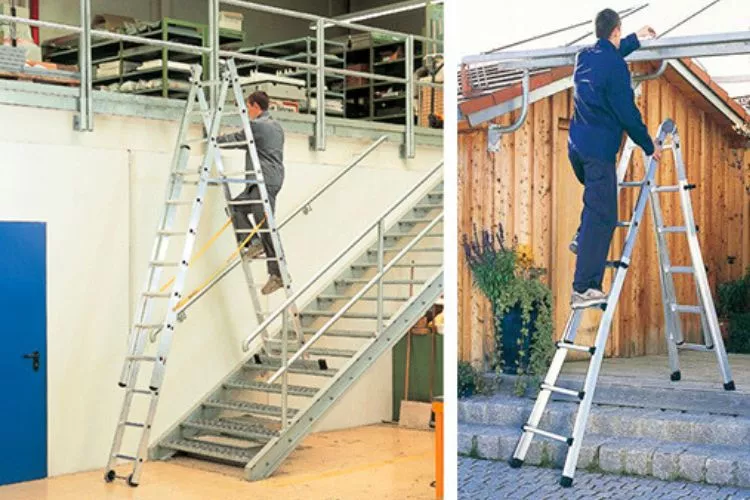
Always maintain a firm grip and face the ladder while climbing. Keep your body centered between the rails and avoid overreaching. Remember the “three points of contact” rule—two hands and one foot, or two feet and one hand should always touch the ladder.
Stay safe and take your time! I have explained more in detail below.
Quick Recommendations
What kind of ladder do I need for stairs?
Articulating ladders are a good option for use on stairs. They are also known as multi-position or combination ladders because they can be adjusted to different positions, such as an A-frame ladder, extension ladder or stairway ladder.
This makes them versatile and ideal for use on uneven surfaces such as stairs.
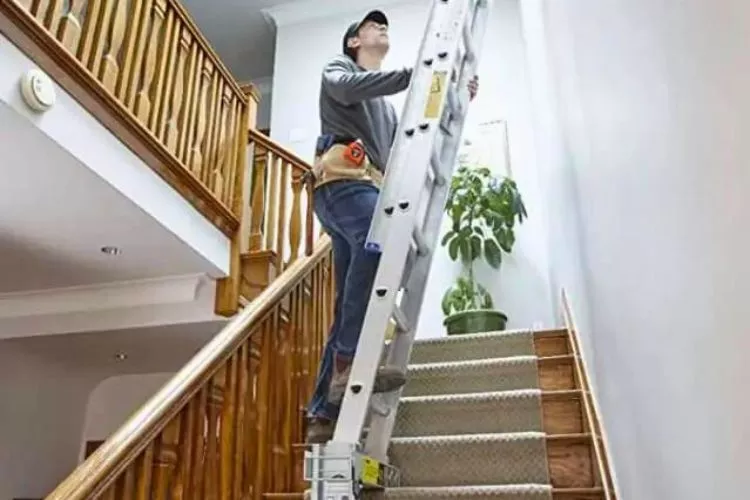
However, it is important to note that articulating ladders can be heavier than a traditional stepladder. Additionally, they may be more expensive than other types of ladders. Choosing a ladder that is appropriate for the job and following all safety guidelines to prevent accidents or injuries is important.
How to use a ladder on stairs? (If You Don’t Have Articulating ladders)
Using ladder aides and ladder extension legs on stairs is a game changer for safety and efficiency. These versatile tools significantly reduce the risk of accidents while providing a stable foundation for any ladder-based task.
Ladder aides allow for easy ladder leveling on uneven surfaces like stairs, ensuring the user has a secure footing. This prevents dangerous wobbling or tipping, which are leading causes of ladder-related injuries.
Ladder extension legs, on the other hand, offer customizable height adjustments to match the stair’s incline. Extension legs eliminate the need for risky improvisations by providing a balanced working platform, such as stacking objects under ladder feet.
With these two solutions combined, users can confidently tackle tasks on stairs without compromising their safety. By embracing ladder aides and extension legs, we can mitigate potential hazards and uphold the highest industry standards for ladder to use on stairs.
How To Use Aides to Use a Ladder On Stairs
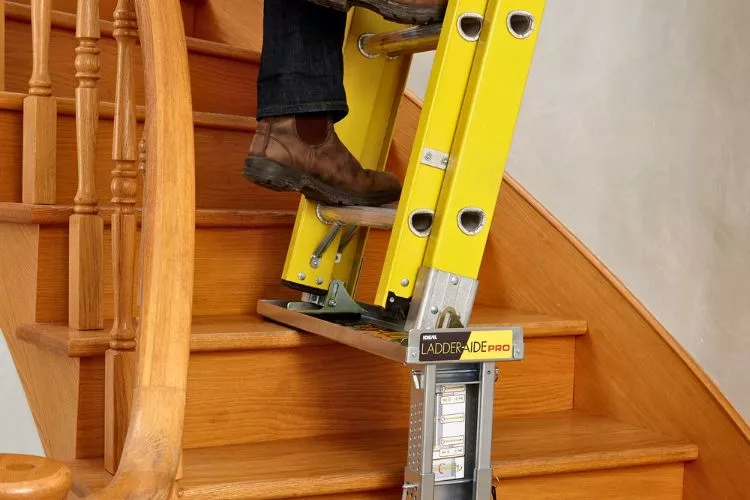
🪜 Setting up the Ladder Aides
- Choose a suitable location on the stairs to set up the ladder.
- Unfold the ladder aides, ensuring the locking mechanisms are securely engaged.
- Adjust the ladder aides’ legs to match the height difference between the stair treads. Check they are level using the built-in bubble level indicator.
- Lock the adjustable legs in place with the locking pins.
🪜 Placing the Ladder on the Ladder Aides
- Position the ladder aides at the base of the ladder, with the flat platforms facing upward.
- Carefully lift the ladder and place the ladder’s feet on the ladder aides’ platforms, ensuring even weight distribution.
- Double-check the ladder aides are level and secure before proceeding.
🪜 Using Ladder Aides to Climb the Ladder
- Make sure the ladder is stable and the ladder aides are still level.
- Firmly grip the ladder’s rails and maintain three points of contact while climbing (Always keep a combination of either one foot and two hands or two feet and one hand in contact with the ladder all times).
- Proceed with your task, maintaining proper balance and body positioning on the ladder.
🪜 Removing the Ladder Aides from the Ladder
- Carefully descend the ladder, maintaining three points of contact.
- Ensure the area around the ladder is clear.
- Carefully lift the ladder’s feet off the ladder aides’ platforms.
- Move the ladder to a safe location before disassembling the ladder aides by unlocking the adjustable legs and folding them up.
🪜 Tips and Tricks
- Always inspect the ladder aides for damage or wear before use.
- Use non-slip rubber mats beneath the ladder aides for stability on slippery surfaces.
- Practice adjusting the ladder aides on level ground to familiarize yourself with the process before using them on stairs.
- Work with a partner to set up and remove ladder aides for added safety and support.
Using Ladder Extension Legs on Stairs
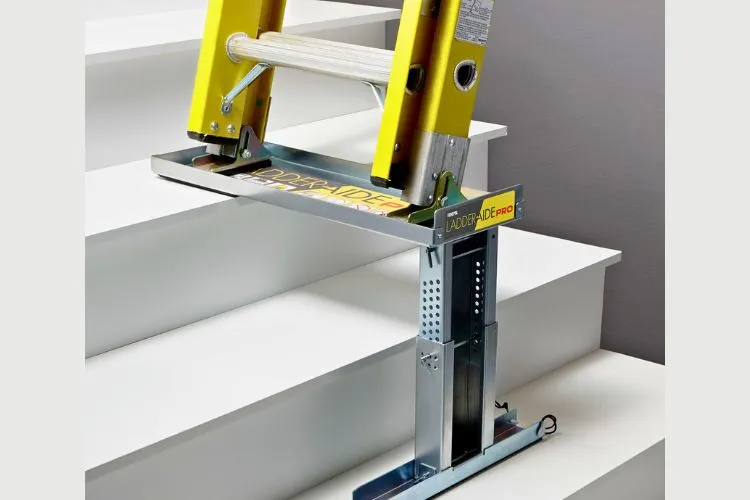
🪜 Preparing the Ladder and Extension Legs
- Select a suitable location on the stairs for ladder placement.
- Unfold and set up the ladder according to the manufacturer’s instructions.
- Inspect the ladder extension legs for any damage or wear before use.
🪜 Attaching the Ladder Extension Legs
- Identify the higher side of the stairs where the extension legs will be attached.
- Attach the extension legs to the ladder’s corresponding side according to the manufacturer’s instructions. This typically involves sliding the extension legs onto the ladder’s rails and securing them with locking mechanisms.
- Adjust the extension legs to match the height difference between the stair treads, ensuring the ladder remains level.
🪜 Positioning the Ladder on the Stairs
- Carefully position the ladder on the stairs, with the extension legs resting on the higher stair tread.
- Check that the ladder is level and stable using a bubble level indicator or another leveling device.
- Secure the ladder by engaging any additional locking mechanisms on the extension legs.
🪜 Climbing the Ladder Safely
- Verify that the ladder is stable and the extension legs are securely attached.
- Maintain three points of contact while climbing the ladder (one foot and two hands, or two feet and one hand).
- Proceed with your task, ensuring proper balance and body positioning.
🪜 Removing the Ladder Extension Legs
- Carefully descend the ladder, maintaining three points of contact.
- Ensure the area around the ladder is clear and safe.
- Remove the ladder extension legs according to the manufacturer’s instructions, typically by disengaging the locking mechanisms and sliding the extension legs off the ladder’s rails.
🪜 Tips and Tricks
- Always inspect the ladder and extension legs for damage or wear before use.
- Familiarize yourself with the extension legs’ attachment and adjustment process on level ground before using them on stairs.
- Use non-slip rubber mats or ladder stabilizers if the stairs are slippery or uneven.
- Consider working with a partner when attaching and removing ladder extension legs for added safety and support.
Other Ladder On Stairs Hack To Save Money
Why spend money on specialized equipment when you can cleverly repurpose household furniture as a makeshift ladder platform?
As a homeowner, I’ve discovered that repurposing household furniture as a makeshift ladder platform can be an innovative solution for reaching elevated areas without investing in specialized equipment.
I can create a stable and secure surface for ladder placement by using sturdy items like bookshelves, tables, and chairs. However, I always ensure that the furniture can support the ladder’s weight and maintain balance for safety reasons.
Through trial and error, I’ve also found that scaffolding and other creative hacks can provide a stable, secure, and adaptable work environment. Not only do they save money, but they also make tackling those hard-to-reach spots on the stairs easy.
- Use a step stool or a sturdy chair: If you only need to reach the first few steps of a staircase, a step stool or a sturdy chair can be a great alternative to a ladder.
- Make your own scaffolding: If you need to work on a larger area of the stairs, you can use wooden planks and ladders. This will provide a more stable and secure work platform than a regular ladder.
- Use a tension rod: A tension rod can be a great solution if you need to hang a painting or other decor on the stairs. Adjust the rod to fit snugly between the walls and hang your item from it.
How to use a ladder on stairs to paint
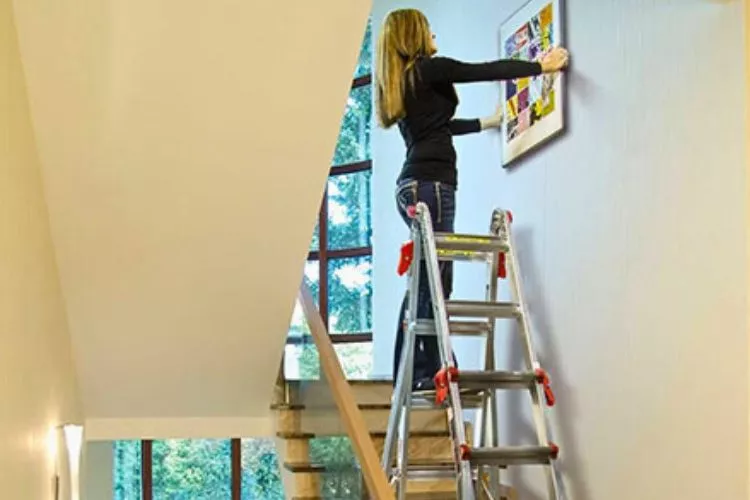
🪜 Step 1: Choose the Right Ladder
The first step to using a ladder on stairs is to select the right one. Your ladder’s size and weight capacity should match the job at hand, so it’s important to choose wisely.
For example, if you’re painting an area with high ceilings or windowsills, consider using an adjustable ladder instead of one with fixed height settings.
This way you can adjust your reach accordingly without changing ladders mid-project or risk falling off while trying to reach something high up in the air!
If possible (and safe), try out your chosen model before buying it; make sure it feels sturdy enough for what you intend to do with it later down the road–you don’t want anything breaking under pressure!
🪜 Step 2: Set Up the Ladder
Now that you’ve chosen the right ladder, it’s time to set it up. This is where things get tricky–and potentially dangerous! Make sure that you have a stable surface to work on and that you’re using a sturdy ladder that can support the weight of both you and your supplies.
If you’re using an extension ladder (the kind with two side rails), place it so that one leg is on each side of the wall; if possible, position your body between these legs for added stability.
If possible, angle the top end of each side rail away from where they meet at 90 degrees; this will help prevent tipping over when climbing up or down with heavy materials.
When working alone with an extension ladder (or any other type), use caution: Always have someone nearby who can spot for safety purposes if needed–and never attempt any task beyond what is recommended by manufacturers’ instructions!
🪜 Step 3: Prepare the Area
- Cover the stairs with a drop cloth to protect them from paint splatter.
- Remove any furniture or objects from the area, including railings and handrails.
- Secure any loose railings or handrails with tape or clamps, if necessary.
🪜 Step 4: Climb the Ladder
Now that your ladder is set up, it’s time to climb. Here are a few tips for climbing safely:
Wear the appropriate safety gear. You should always wear gloves and goggles when painting, especially when using ladders. If you don’t already have them, pick them up at your local hardware store before starting this project!
Use the ladder’s handrails for balance as needed–don’t lean too far to either side while ascending or descending. This will help keep you steady on your feet and prevent any accidents from happening in case of an unexpected slip-up (which can happen even if everything seems secure).
Frequently Asked Questions (FAQs)
How do you get a high ceiling over stairs?
You can use ladders or scaffolding to reach a high ceiling over stairs. Using an extension roller can also help. First, dust the ceiling with a broom and cloth to remove cobwebs and dust. Then, wear a dust mask and use a rag to brush the ceiling, laying a rag over the end of the broom for hard-to-reach spots.
Can I use Little Giant ladder on stairs?
Yes, you can use a Little Giant ladder on stairs with the help of a ladder leveler accessory. This accessory helps to level the ladder on stairs, making it safe and stable for use.
Can I use gorilla ladder on stairs?
Yes, you can use a Gorilla ladder on stairs, but it is important to use it safely. Make sure the ladder is securely set up and level on the stairs, and always face the ladder and maintain three points of contact while climbing.
While using a ladder on stairs can be manageable with the right tools and techniques, it’s important to always prioritize safety and take some extra precautions to ensure a secure working environment. Even with specialized equipment like ladder aides or extension legs, there are some general tips that can further enhance your safety:
- Always Inspect Your Ladder: Before using a ladder on stairs, always inspect it for any damage or wear. Ensure that all rungs are secure, the ladder is free from cracks, and the locking mechanisms are functioning properly. If any part of the ladder is damaged, it’s best to replace it before use to prevent accidents.
- Avoid Overloading the Ladder: Never exceed the ladder’s weight capacity, including your own weight and the weight of any tools or materials you’re using. Overloading the ladder can compromise its stability and increase the risk of a fall.
- Check for Stability Regularly: When working on stairs, the ground beneath the ladder can be uneven, which makes stability crucial. Regularly check that the ladder remains level and stable as you climb, especially if you’re using extension legs or ladder aides. Any sign of wobbling should be addressed immediately before continuing.
- Wear Appropriate Footwear: Ensure that you wear shoes with non-slip soles while working on a ladder. Slippery footwear can cause you to lose your balance while climbing or descending the ladder. Avoid sandals or shoes with smooth soles and opt for sturdy work boots instead.
- Work with a Partner: If possible, always have a second person on hand to help steady the ladder or pass tools and materials to you. A partner can assist in maintaining the ladder’s stability, allowing you to focus on the task at hand without distractions.
- Consider the Weather: If you’re working outdoors or on stairs near windows, ensure that weather conditions are favorable. Wet or windy weather can make it much more difficult to maintain your balance on the ladder, so it’s important to check the forecast before starting your task.
By following these tips, you’ll reduce the risk of injury and ensure that your ladder is safe and stable when working on stairs, making your project more efficient and secure.
Conclusion:
In conclusion, learning how to use a ladder on stairs can be a challenging but essential task for various home improvement projects. You can successfully navigate this tricky process by choosing the right ladder, setting it up securely, and following safety precautions.
Remember to enlist the help of someone if needed, and always prioritize safety above all else. With the right approach, you can overcome the obstacle of working on stairs and achieve stunning results in your home.





